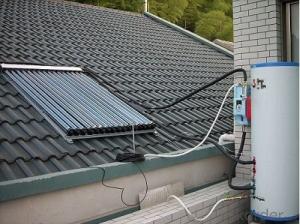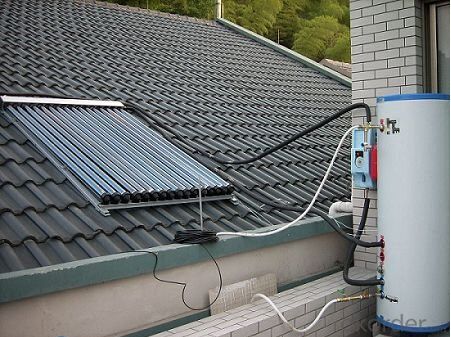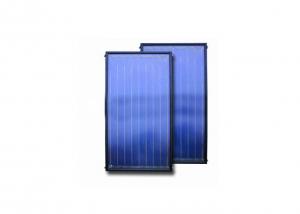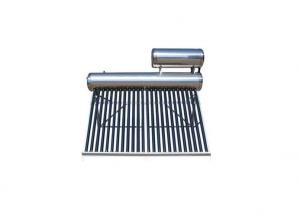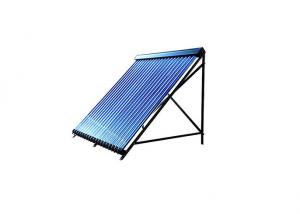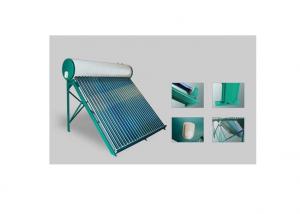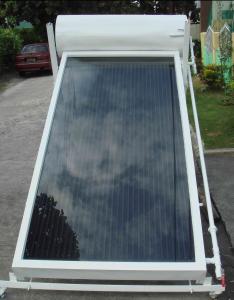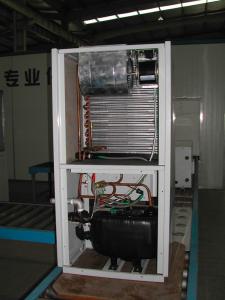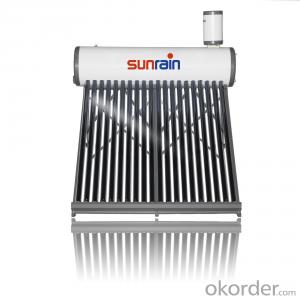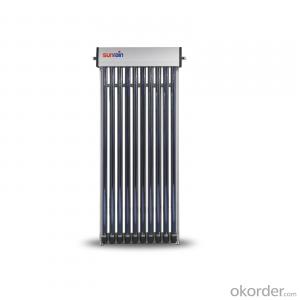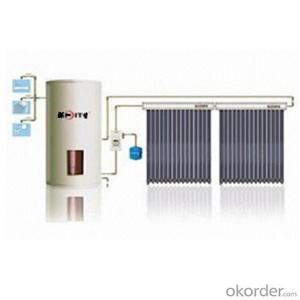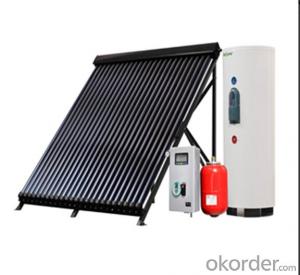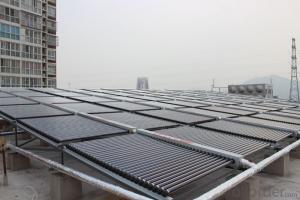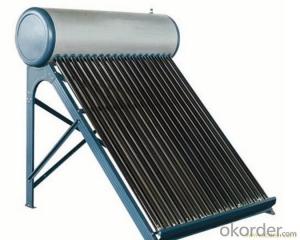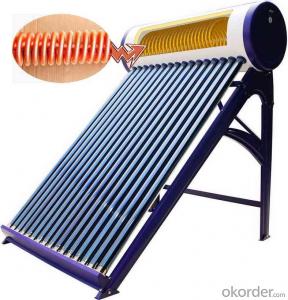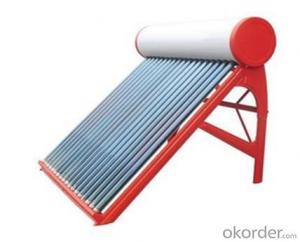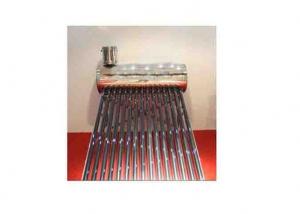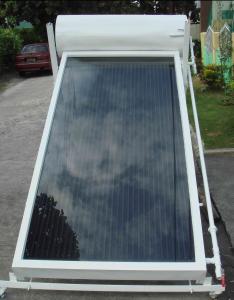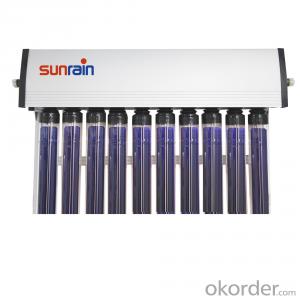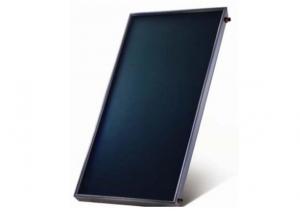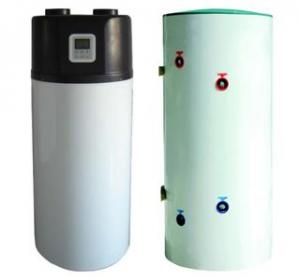Split Solar Water Heater for Pool with Two Copper Coils Inside Water Tank Model SS-M2
- Loading Port:
- Shanghai
- Payment Terms:
- TT OR LC
- Min Order Qty:
- 1 set
- Supply Capability:
- 2000 set/month
OKorder Service Pledge
OKorder Financial Service
You Might Also Like
1. Structure of Split Solar Heating System with Two Copper Coils inside Water Tank Model SS-M2
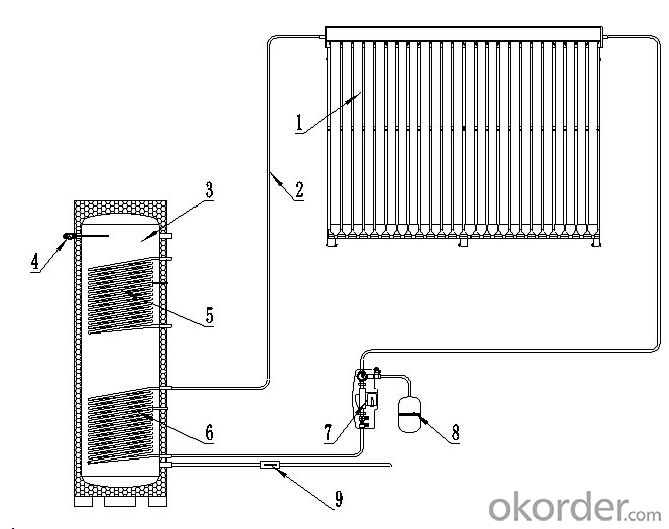
1 Flat Panel Collector;
2 Circulation Pipe;
3 Water Tank;
4 T/P Valve;
5 Upper Copper Coil;
6 Bottom Copper Coil;
7 Work Station;
8 Expansion Tank;
9 Check Valve
2. Main Features of Split Solar Heating System with Two Copper Coils inside Water Tank Model SS-M2
Food-grade stainless steel SUS304-2B inner tank
High heat transfer efficiency
Combined with auxiliary electricity, gas and other boiler
Easy installation according to the structure of the room
Integrated workstation,different Temperature cycle,make system efficient and help save energy
3. Split Solar Heating System with Two Copper Coils Inside of Water Tank Model SS-M2 Images
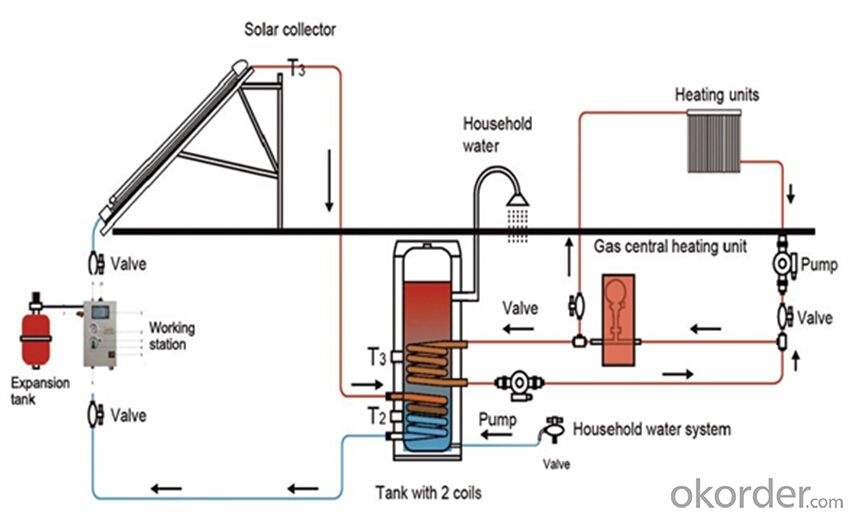
4. Split Solar Heating System with Two Copper Coils Inside Water Tank Model SS-M2 Specification
System model | SS-M2-150 | SS-M2-200 | SS-M2-250 | SS-M2-300 | SS-M2-400 | SS-M2-500 |
Tank capacity(L) | 150 | 200 | 250 | 300 | 450 | 500 |
Copper coil qty | 1/2 | 1/2 | 1/2 | 1/2 | 1/2 | 1/2 |
Solar collector model | SC-H-15/20 | SC-H-20/24 | SC-H-25/30 | SC-H-30/20 | SC-H-20/24 | SC-H-25/30 |
Solar collector qty | 1/1 | 1/1 | 1/2 | 1/2 | 2/2 | 2/2 |
Controller model | SR868C8 | SR868C8 | SR868C8 | SR868C8 | SR868C8 | SR868C8 |
Work station model | VSP-S1 | VSP-S1 | VSP-S1 | VSP-S1 | VSP-S2 | VSP-S2 |
Expansion tank spec | 12L | 12L | 18L | 18L | 24L | 24L |
Medium volume | 12L | 12L | 18L | 18L | 24L | 24L |
Recommended Flow | 1.0~2.0L/min | 1.2~2.5L/min | 1.5~3.0L/min | 3.0~5.0L/min | 4.0~7.0L/min | 5.0~8.0L/min |
Max temperature of tank | 95℃ | 95℃ | 95℃ | 95℃ | 95℃ | 95℃ |
Max temperature of system | 95℃ | 95℃ | 95℃ | 95℃ | 95℃ | 95℃ |
Rated pressure of the tank | 0.7MPa | 0.7MPa | 0.7MPa | 0.7MPa | 0.7MPa | 0.7MPa |
Media pre pressure | 0.2~0.3MPa | 0.2~0.3MPa | 0.2~0.3MPa | 0.2~0.3MPa | 0.2~0.3MPa | 0.2~0.3MPa |
Max pressure of system | 0.6MPa | 0.6MPa | 0.6MPa | 0.6MPa | 0.6MPa | 0.6MPa |
Voltage | AC220V 50Hz | AC220V 50Hz | AC220V 50Hz | AC220V 50Hz | AC220V 50Hz | AC220V 50Hz |
Recommended pipe diameter | φ15 | φ15 | φ15 | φ15 | φ22 | φ22 |
5. FAQ
Q1. Will water be heated on a cloudy day?
Re: Yes. Although the heat output of the solar collector is reduced on overcast days it will still be able to provide heat. If it is a heavily clouded day or raining, then more gas or electric boosting may be required to maintain water at the required temperature. This system will be automated so you don't have to worry about running out of hot water on a rainy day.
Q2. Can I use a solar collector with my existing hot water system?
Re: Normally yes. Simple retrofit valves can often be used to allow solar collector to connect to your existing cold water inlet. If your tank cannot accept the solar input directly, an additional storage tank can be installed to pre-heat the cold water prior to entering the existing tank.
- Q: What is the difference between a solar water heater and a solar panel?
- A solar water heater is specifically designed to heat water using solar energy, whereas a solar panel is used to convert sunlight into electricity.
- Q: Are there any limitations on the placement of a solar water heater on a building?
- Yes, there are some limitations on the placement of a solar water heater on a building. The primary limitation is the availability of direct sunlight. Solar water heaters need to be installed in a location that receives ample sunlight throughout the day, preferably facing south. Additionally, there should be enough space on the roof or ground for the solar panels and water storage tank. Local building codes and regulations may also have specific requirements or restrictions on the placement of solar water heaters.
- Q: Can a solar water heater be used in areas with high altitude?
- Yes, a solar water heater can be used in areas with high altitude. In fact, solar water heaters are often more efficient at higher altitudes due to the thinner atmosphere and increased solar radiation. However, it is important to consider the specific conditions and requirements of the area, such as extreme cold temperatures or strong winds, to ensure proper installation and performance of the solar water heater.
- Q: Are there any disadvantages of installing a solar water heater?
- Yes, there are a few disadvantages of installing a solar water heater. Firstly, the upfront cost of purchasing and installing a solar water heater can be relatively high compared to traditional water heaters. Additionally, the effectiveness of a solar water heater is largely dependent on the availability of sunlight, so it may not perform optimally in cloudy or shaded areas. Maintenance and repairs can also be more expensive and specialized due to the complex nature of the system. Lastly, solar water heaters usually require ample space for installation, which may not be feasible for all households or buildings.
- Q: Can a solar water heater be installed in a location with limited sunlight?
- While it is technically possible to install a solar water heater in a location with limited sunlight, its effectiveness and efficiency may be greatly reduced. Solar water heaters rely on sunlight to generate heat, so a lack of direct sunlight would result in lower water temperatures and a reduced overall performance. It is recommended to assess the available sunlight in the location before considering the installation of a solar water heater.
- Q: How long does it take for a solar water heater to heat up water?
- The time it takes for a solar water heater to heat up water depends on various factors such as the size and efficiency of the system, the amount of sunlight available, and the initial temperature of the water. However, on average, a well-designed and properly functioning solar water heater can heat up water to desired temperatures within a few hours.
- Q: How does the flow rate of the water affect the performance of a solar water heater?
- The flow rate of the water affects the performance of a solar water heater by determining how efficiently the water can be heated. A higher flow rate allows for a greater volume of water to be heated, but it may result in a lower temperature increase as the water passes through the solar collectors. On the other hand, a lower flow rate allows for a higher temperature increase, but it limits the amount of hot water that can be produced. Therefore, finding the optimal flow rate is crucial to ensure both efficient heating and an adequate supply of hot water from the solar water heater.
- Q: What is the required maintenance for a solar water heater?
- The required maintenance for a solar water heater typically includes checking the system's components, such as the collector, pipes, and valves, for any signs of damage or leaks. It is also important to clean the collector regularly to remove any debris or dirt that may reduce its efficiency. Additionally, the fluid in the system may need to be checked and topped up if necessary. Overall, regular inspection and cleaning, as well as professional servicing every few years, are recommended for optimal performance and longevity of a solar water heater.
- Q: How does a solar water heater impact the electricity consumption of a household?
- A solar water heater can significantly reduce the electricity consumption of a household by using the energy from the sun to heat water instead of relying solely on electricity. This means that the household would require less electricity to heat their water, resulting in lower energy bills and a reduced carbon footprint.
- Q: Can a solar water heater be used in areas with limited access to suitable installation sites or roof space?
- Yes, a solar water heater can be used in areas with limited access to suitable installation sites or roof space. In such cases, alternative installation options can be considered. For example, if there is limited roof space available, a ground-mounted system can be installed. This involves placing the solar panels on a rack or structure on the ground, where they can still receive ample sunlight. Additionally, if there are space constraints, compact or smaller-sized solar water heaters can be utilized. These systems are designed to be installed in smaller areas such as balconies or utility spaces. Therefore, while access to suitable installation sites or roof space may be limited, there are alternative options that can still allow for the installation and use of a solar water heater.
Send your message to us
Split Solar Water Heater for Pool with Two Copper Coils Inside Water Tank Model SS-M2
- Loading Port:
- Shanghai
- Payment Terms:
- TT OR LC
- Min Order Qty:
- 1 set
- Supply Capability:
- 2000 set/month
OKorder Service Pledge
OKorder Financial Service
Similar products
Hot products
Hot Searches
Related keywords
